The third part of The DAVID MACK INTERVIEWS, and this time he and author Chuck Palahniuk talk about their recent work on Fight Club 2, the graphic novel sequel to the modern classic.
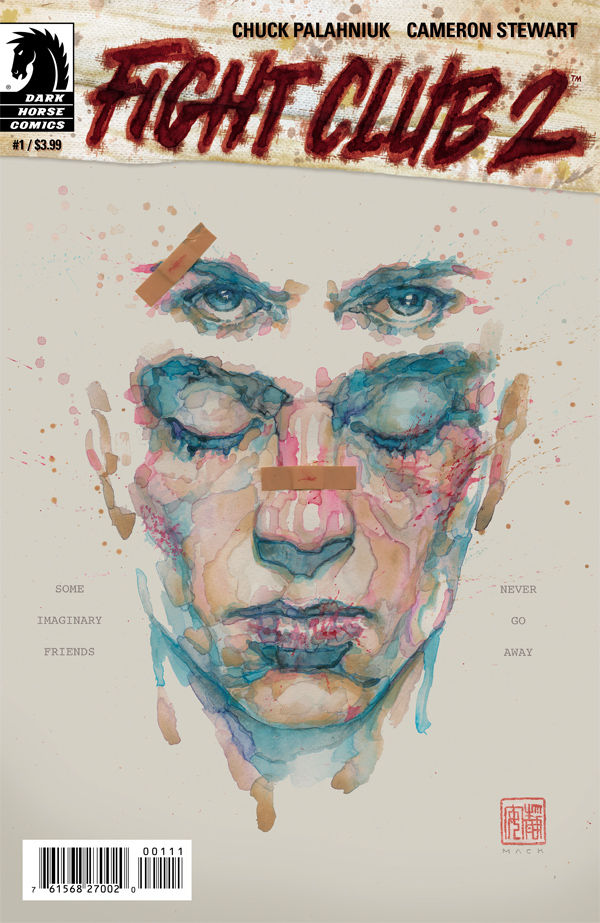
By G.D. KENNEDY
For anybody who is a product of late-stage Generation X, Chuck Palahniuk’s Fight Club was one of those iconic, watershed works of art that managed to capture the confusion, apathy, social isolation and impotence that were hallmarks of a vastly changing global and corporate landscape. Focusing on The Narrator and his split personality Tyler Durden, the book explored the attempts of disillusioned men to assert their own identities and destinies through Project Mayhem, a fight club that grew from underground fights into a broader cult of socio-cultural antagonism, a reinvention of tribalism set in modern America.
Incredibly, Fight Club came out 20 years ago but even now, the book’s underlying message still resonates. Last year, Dark Horse began publishing Fight Club 2, a comic sequel to the original book, written by Palahniuk with art by Cameron Stewart and beautiful painted covers by David Mack. In Fight Club 2, Palahniuk returns to his characters who are a decade-plus older, but the story itself is bigger and broader than the original, taking a critical eye at many of the themes in the original and, in particular, examining what it means for Project Mayhem to evolve from a mere subgroup to a global conglomerate, and what that means for its message. It is an engaging, challenging, bizarre and effective sequel. Yet it veers decidedly from its origins and plays in meta-concepts, suggesting ultimately that the path to self-determination is far deeper than sheer rejection of conformity.
Mack’s been here at 13th Dimension in recent weeks, talking about Kabuki Library Edition Vol. 3 (click here) and Jessica Jones (click here) and his many other projects. This week, David talks about his work on Fight Club 2, and he’s joined by Palahniuk. Here is what they have to say:
—
G.D. Kennedy: Chuck Palahniuk’s name appears throughout Kabuki Library Edition Vo. 3. How long have you known Chuck for?
David Mack: We first met in early 2006. We had lunches at the Bagdad Theater in Portland and the crepe place on Hawthorne. I had written to Chuck and sent him some of my work, and he responded with a very encouraging and creatively ambitious letter and an invite to meet for lunch. I included one of his early letters in the new Kabuki Library Edition Vol 3. It reads fascinating now in context to us now working on Fight Club 2 together.
Chuck wrote that the documentary film about my work, The Alchemy of Art, spoke to similar themes that he finds himself telling people about the creative process. He said that he had a dream of putting together a kind of Ken Kesey bus tour in which creators from different media “visit students to prove that human beings create their own culture — they don’t just buy it.”
We would meet up and talk in detail about our creative process. The discussions were so heady and inspiring that afterwards, I’d be back at [Brian Michael] Bendis’ place typing up the conversations in play form as quick as I could so I didn’t forget any of it. I have a kind of fantasy of illustrating those “Lunches with Chuck” scripts as a very expressive comic format chronicling the creative discussions. Around that time Chuck wrote a generous introduction to Kabuki: The Alchemy. It is now collected in the new Kabuki Library Vol 3.
G.D.: It sounds like Chuck was someone you bounced some ideas and concepts off of and played a role in creating The Alchemy. What was Chuck’s role in creating the Alchemy?
David: In that letter from Chuck that I published in the back of the current Kabuki book, he talks about a mentor or teacher giving you a kind of license to create. A kind of formal validation that it’s OK to just do what you wanted to do when some people don’t have the full initiative to do that on their own without the validation that a class or teacher or mentor can give.
That bit of Chuck’s letter inspired me to have a character in the story, Akemi, create an actual “Artistic License” that she gives to the Kabuki character to underscore her catalyzation of her new direction. And to this day, I include that actual “Artistic License” in the back of each book. Readers send photos of them to me with their name and photo filled out in the license. Gawakoto clothing and MMA fight gear printed their Kabuki shirts with the Artist License on the back. Its become a kind of calling card for a movement of self-initiative.
I included other things Chuck had sent to me collaged into the art of the Kabuki story in this book as well. For instance, there were these glow in the dark stars and moon he sent in a package that are in the background of some pages.
G.D.: Fight Club first came out in 1996 and the movie in 1999, some 20 years ago. Why did you decide that now was the time to come back to this story and these characters?
Chuck Palahniuk: Almost 20 years ago Marvel and DC had asked me to write a limited-edition series, but I couldn’t risk stalling my career for the year or two it would take to learn to write a comic script. More recently I had the time: My story collection Make Something Up was finished, and I had friends in Portland — editor Scott Allie, Matt Fraction, Brian Michael Bendis, and Kelly Sue DeConnick — who offered to mentor me in the new storytelling form. The original Fight Club story had established so many characters and dynamics, it seemed only natural to revisit them.
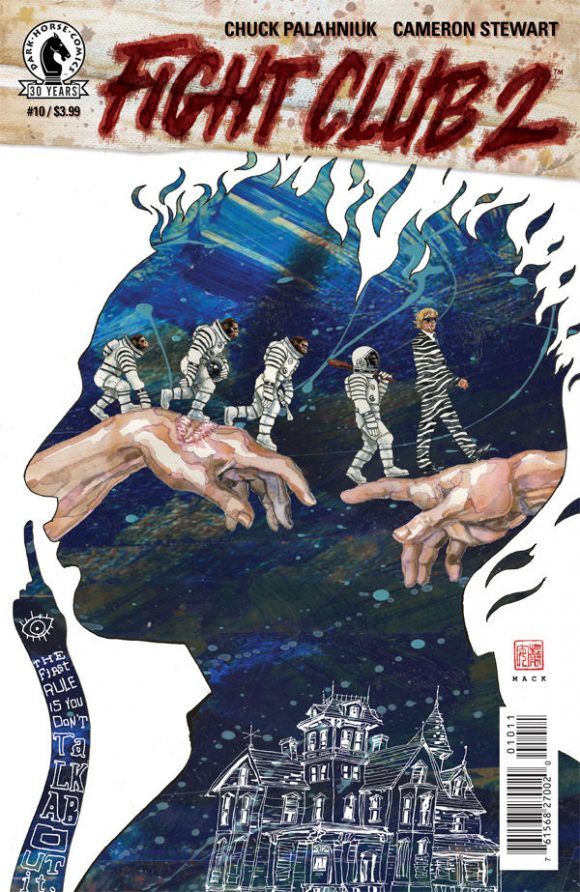
G.D.: David, was the original Fight Club something that had an impact on you? What was your reaction when you found out about the possibility of working on the sequel?
David: I saw the film the night it came out. It had such an effect that I saw it the following night as well. I related to several things in the film. For years before that, I was starting my work, and invited another artist to live in my house with me and embark on our creative work. We were making comics and art, not soap … but we had a comparable living arrangement as Tyler and The Narrator.
The movie crystallized the idea that everyone is on a limited timeline and the metaphorical gun to the head to stop doing what society or convenience wants you to do, but ‘follow your ridiculous dream’ connected with me as a theme on a very personal level.
There were also writing approaches that I related to. I had to find out who this writer was that the story was based on. I went and bought all the books that Chuck had out at that time and read them all on trains in Paris. I was very enthused to be a part of collaborating with Chuck in any way … especially on the next story of Fight Club.
G.D.: Chuck, for Fight Club 2, you opted to move away from prose to a comic book. What was behind the decision to do this?
Chuck: Opportunity. I had the time. I got the support. And I’d been to comic cons and seen a culture that seemed more relaxed and fun than the traditional literary world. I wanted to be part of the fun, nerdy crowd.
G.D.: David, did you have any role in encouraging him to make the sequel a graphic novel?
David: Brian Michael Bendis used to have this joke about Chuck and I. When I was staying at Brian’s place in Portland, I would come back to his place and tell him I had been meeting with Chuck. But Brian hadn’t actually seen or met Chuck. Brian said he imagined Chuck was my Tyler Durden. That if he went to the restaurant, he imagined seeing me trough the window sitting at the table alone and wildly talking to myself.
Back in my early meetings with Chuck in 2006, I had talked to him about writing comics because at the time Brian Michael Bendis and I were co-writing Daredevil: End of Days together. I was telling Chuck about what a joy it was to write collaboratively with someone, and the joy of collaborating with artists Bill Sienkiewicz and Klaus Janson on the project. Chuck asked me questions about the collaborative nature of the process and I think that intrigued him.
Chuck expressed an interest in writing for comics. Later he was at a dinner at Bendis’ house and when he asked what might be a good story for him to try in comics, I believe Brian suggested the Fight Club sequel as a comic.
G.D.: Chuck, in a comic, you are reliant on others — in particular, the artist — to create a collaborative piece, in ways that you wouldn’t otherwise need to be in prose. What was the level of input from Cameron and David in crafting the story?
Chuck: Before a panel was drawn, we met for several weeks in Portland with the editor, Scott Allie, and colorist Dave Stewart, to establish the look of each alternate plotline: The flashbacks, the dream sequences, the parallel plots, and the meta elements. These included the “real” objects such as pills and rose petals that would litter the page and obscure faces and dialogue. Cameron even designed a three-dimensional model of the Project Mayhem house so he could depict it from any angle with complete consistency.
G.D.: Looking back at the series, any thoughts on working in a different medium?
Chuck: FC2 wasn’t the balls-out, spree-killing book it could’ve been. I wanted to withhold some crazy and allow my readers a gentler introduction to the new form. An FC3 will be more wild and appalling now that I’ve established a beachhead.
G.D.: As you suggest, visually, the series uses a number of items — pills, flower petals, sperm, etc. — to overlay the images and even obscure the text and dialogue at times. This feels very unique but, as used, it fits nicely to highlight some of the elements of the book — commodification of the characters, confusion and obstruction of communication. Why did you decide on doing this?
Chuck: In my fiction I’ve always used nonfiction devices such as facts or recipes, even nonfiction storytelling forms like rules and oral-history interview segments, to lend more reality to outlandish events. David Fincher and screenwriter Jim Uhls did a great job of reminding the film’s audience that we were watching a film, and the film breaks, splices, burning, they all had the opposite effect of making the story seem more real. In FC2 we wanted to exploit the mechanics of comics to the same effect, smearing the ink, tweaking the print register, etc.
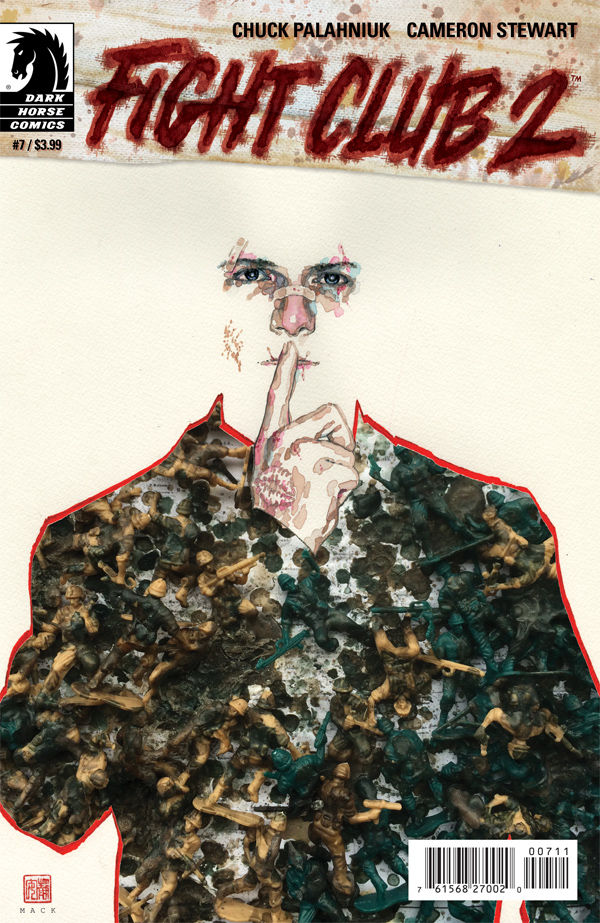
G.D.: Project Mayhem seems to have shifted substantially from the first Fight Club to FC2, as it has become a global enterprise intimately integrated within the the world’s military industrial complex. Why did you decide to move Project Mayhem in this direction?
Chuck: Read some sociology. Successful fringe groups always grow to become powerful institutions. Look at Burning Man.
G.D.: I think one of the concepts that grabbed me about FC2 was the way in which Project Mayhem had shifted from an entity that was more concerned with pressing participants to their potential, to exercising control over the world to mold it into its desired image. This feels like the life cycle for so many revolutionary movements — bold ideals that ultimately can only be expressed through overt control. Is this something you were looking to explore in this book?
Chuck: Bingo. But comics wouldn’t allow me to state it overtly. My original dream was that fight clubs would help create individuals who would spin away to begin their own empowered lives. That’s the ideal. But too often so-called empowering groups suck people in to perpetuate and grow the group’s power. That is the dark, wrong turn that Project Mayhem has taken.
G.D.: One interesting wrinkle you added to Fight Club 2 was Tyler Durden as almost an infectious meme. I suppose that was always there in the original Fight Club, in that his ideas caught on with so many people, but in FC2, Durden himself becomes transmittable. What led you to evolve Durden in this manner?
Chuck: Do you remember the magazine Adbusters? I loved it. And I loved how it made me aware of the memes surrounding me, from cereal boxes to clothing labels. I wanted to tie memes to archetypes. Tyler Durden spouts memes, but he’s a classic trickster character. Tyler ties the ancient to the modern.
G.D.: One element in this story that jumps out is the meta component — you insert yourself into this story, not only as a character but as a fulcrum for the story itself. Why did you decide to use the meta-element as such a critical element of the story?
Chuck: Again, it’s about seeking community. My writing workshop has always been a key social outlet. So I wanted to drag all of my writing peers — Chelsea Cain, Monica Drake, Lidia Yuknavitch and Suzy Vitello — into the story. Lit critics claim that [Ken] Kesey populated his mental hospital with the people in his own Stanford University writers group, and that Toni Morrison filled her plantation in Beloved with her fellow workshop writers. I wanted to mix my literary fiction world with my comic world, like throwing a party to bring all my far-flung realities together. Integration.
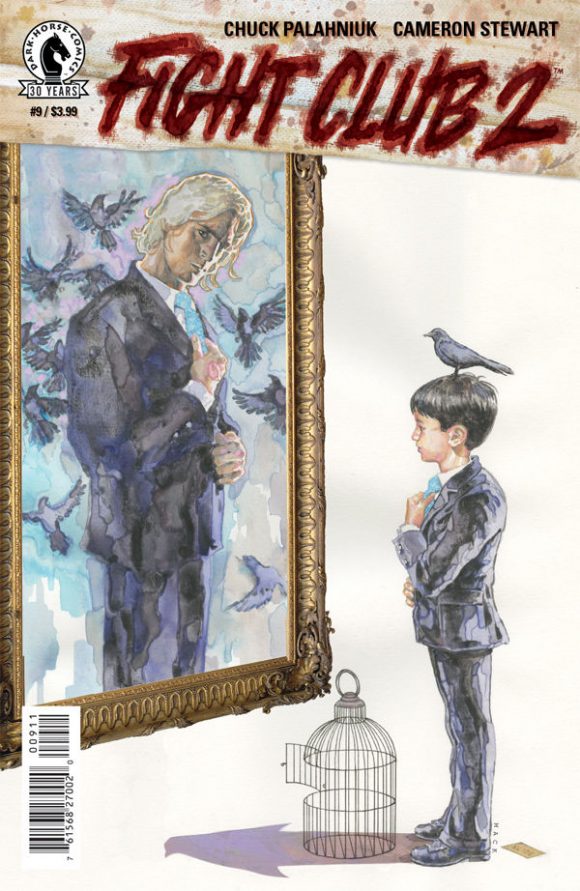
G.D.: What was the impetus for weaving yourself into the story?
Chuck: I sacrifice some of my own reality to give Tyler more reality.
G.D.: The world obviously has changed substantially since the first Fight Club came out. Does its message still resonate with you?
Chuck: Yes, I still need to exhaust myself through structured, consensual chaos. Often this takes the form of my book events, but sometimes simply writing a wild story can leave me sated.
G.D.: Robert Paulson, who didn’t make it out of the first Fight Club, returns as a deus ex machinA throughout FC2. What brought this about?
Chuck: The readers. Bob was going to stay dead until I met so many comic-con goers who expressed their love for Bob and wanted him to return. It took some rewriting, but I wanted to make people happy.
G.D.: David, You’ve done covers for each of the 10 issues, plus the hardcover. How did you come to be the cover artist for the series?
David: I had told Chuck in the past that I’d be happy to collaborate with him in any way. And when I emailed to him to consider Dark Horse for Fight Club 2, I told him that I’d be happy to be a part of this project in any way he saw fit.
I was working with Dark Horse editor Scott Allie on preparing the Kabuki Library Editions, and I let him know I’d be happy to be a part of the project in any way. Whether it be behind the scenes or in any capacity of the book. Then when I was in Mexico in early 2014 I got a call from Scott Allie that he and Chuck wanted me to do the covers for the series. I remember I was walking around Mexico with Brian Bolland and Joe Staton at the time, and had this exciting call about the Fight Club project and the offer to do the covers.
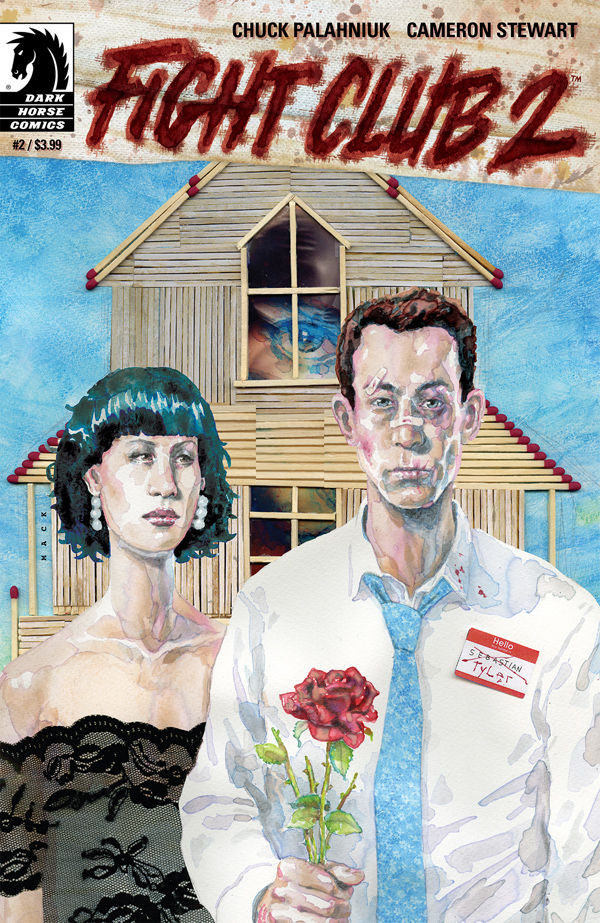
G.D.: The covers that you did for Fight Club 2 are really a diverse mix of images and styles, many of which are pretty abstract. Can you tell us a bit about the process for deciding on the cover image for each piece? For the particular style that you selected?
David: For Fight Club 2, I read the script as soon as I got it. I made notes all through the script of cover ideas for it. When working on cover, I go back to that script and it is filled with wonderful imagery ideas for the covers.
I send my cover ideas for editor Scott Allie and Chuck to react to. Often Chuck or Scott will have notes and I’ll percolate on that and react to that in the image. I imagine I am doing a lot of this work on both a conscious level and in collaboration with the unconscious. A challenge and appeal of this is to give voice and image to some of the thoughtful ideas of the story, and try to select the right images to evoke the feel of the emotional and thematic content.
I think the covers will exist as interesting facets of the story. There are details in the story that refer to specific historical figures and historical works of art and literature, and some of the covers play on that. There is a theme of identity in the covers. And a theme of the conscious and the subconscious.
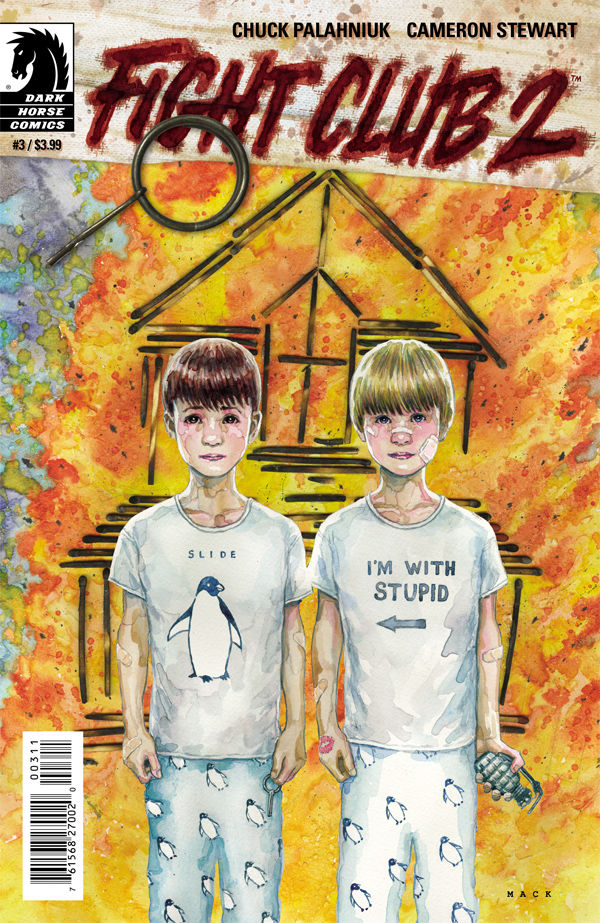
In terms of a loose sequence, Issue #2 shows a house made of matchsticks in the background and issue 3 has burnt matches suggesting a skeleton of a house of fire. Each are specific to the stories in the issues but also can act sequentially. If you look at the close up face on Issue #1, the bandages on that face are in the same place as the full shot of The Narrator on Issue #2. And they correspond to other versions of Tyler on other covers in the series. There are some details like that in many of the covers that are a part of a thematic structure that I build on, but most of those details won’t be consciously noticed by the viewer
For the original promo image for San Diego Comic-Con 2014 I was asked by Scott Allie to create the first visual for the new story. But the idea was to keep it fairly mysterious. We didn’t put the words Fight Club on it at first. Or the character’s name. Scott planned it as a teaser image. I hand wrote the words “The first rule… is you don’t talk about it.” And the idea was to keep the character in shadows. Shirtless. I tried severay different versions of this. Pencil at first. But then went to brush and ink. It was an experiment of what information to leave out and in shadow.
I did over a dozen versions of it until I found just the one that seemed to have the right balance for me. That brush and ink was layered with a watercolor wash in monochromatic red. In a way this set a tone for me of how I wanted to portray the character. I wanted my version of the narrator and Tyler to have continuity with the character versions from the book and the film. To be in continuity with both fo them. The scars, are there, the visual elements. I also wanted to leave a certain amount of mystery to the character. A certain mystique and psychological presence.
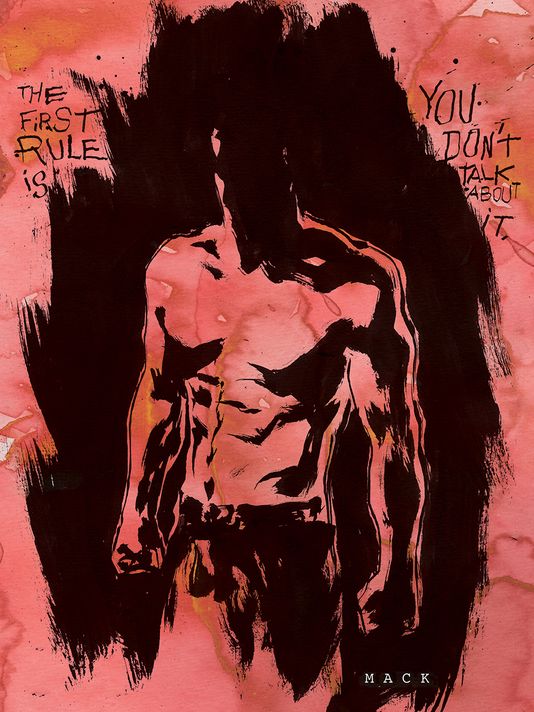
Are there any particular covers that for the series that you’re particularly proud of? Any reason? (I’m personally blown away by the cover for issue 1.)
David: For that cover #1 . . . . There was to be a [Free Comic Book Day] cover that would be needed before the others. Scott sent me some paintings of faces that I had done as previous works, as a kind of tone that he was thinking for this.
I try to think of something that is eye catching and at the same time crystalizes something psychological that pertains to the story, characters, and the issue in particular. In this case, the closed eyes of the bruised and bandaged face of the narrator… but also the open eyes of Tyler.
With that, it came together and I sent Scott that image for the FCBD. But Scott liked it and said he felt like it seemed more like the #1 cover to the main series. I agreed but Scott wasn’t sure there was time to do another image for the FCBD. I just had one night to do something else for the FCBD cover if we were to use this image for the future #1 cover of the series.
So I went to work on a brand new cover for the FCBD issue, and included the name tags with the various names that were in that issue. It tied into the story very directly and we used that.
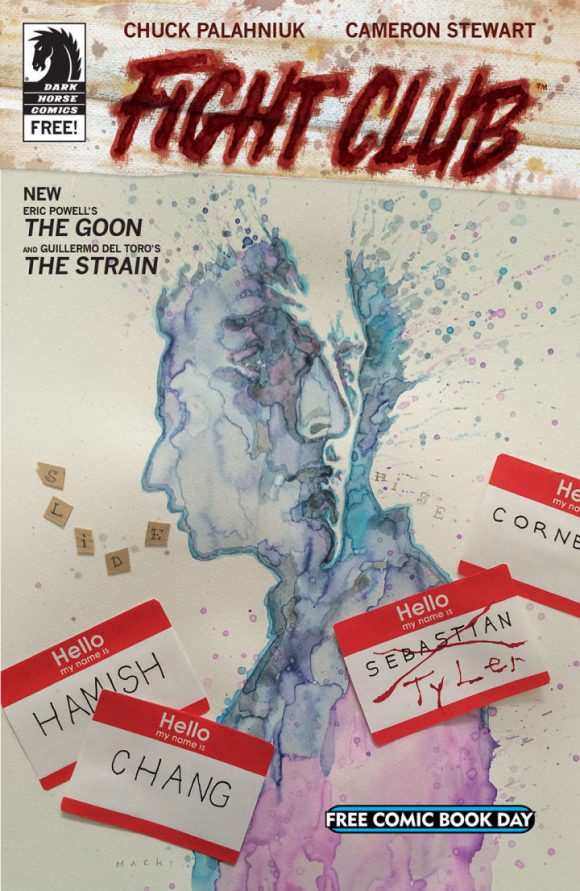
G.D.: Other than working on the covers, did you have any role in Fight Club 2? Did you work with Chuck on the material, or help him acclimate to writing in a new medium?
David: I had some behind the scenes factor in talking with Chuck about Dark Horse and with Scott Allie about Chuck, and the plans. But Chuck’s script was so direct and pure and crystallized. It was so streamlined and elegant. He didn’t bother separating the panels into pages. He left that for the artist to compose. So each issue is Panel 1 … to Panel 279 or whatever. All the beats work, all the information is there. And he left the right room for the artist to be playful and creative with composition as well. He did not get in his own way. He is a very clever writer like that. The script shows all his strengths, and he leaves room for the artist to show their strengths.
The comic has come out with a real life to it. I’ve read the script from the beginning, I’ve seen the stages of it being made. But I just got my copies of the printed (hardcover) book and I read it as a BOOK . . . and it had a magic and an energy and a very visceral life to it. All the parts came together and really sang as a work.
I’m honored and inspired to be a part of this project with Chuck and this creative team. The script is so strong, Chuck’s vision is so powerful, that the work we do flows from that.
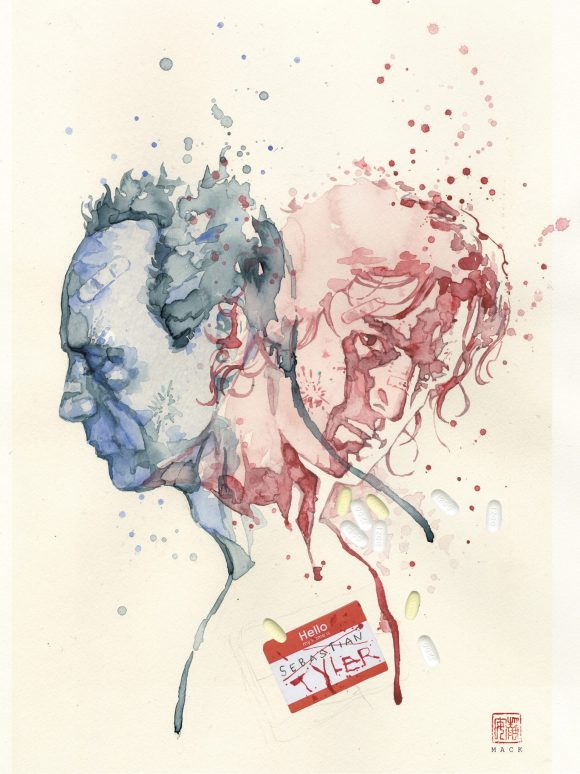
The cover for the upcoming FC2 Library Edition, due in October.
G.D.: Let’s talk about the Fight Club 2 Library Edition.
David: There are a lot of extras of my work included in the Fight Club Library Edition. A lot of the graphic images that I did for the series, and other paintings for when I was figuring out a look for the covers. As well as process and making of the covers and a commentary on how the project came togehter. It’s an incredible package of a book.
Including photos from when we did the panel with Chuck and Fight Club director David Fincher, the early Chuck conversations and origin of the project and more.
I felt a high level of self-imposed pressure because of my own strong connection to the source material and my respect for Chuck’s work and his script. I did a lot of work that wont be seen that got me through a couple of other stages before the current cover images appeared. I put a lot of thought and effort into considering the imagery and icons of this story. I kind of had to work out some of the original imagery and icons out of my system in earlier works before I could get to the next stage to be very specifically serving this story and the unique iconography from this story while keeping it all unified and in a continuum of character and history.
I did a set of very graphic Fight Club imagery. Minimalistic images that I felt captured themes of the characters in direct ways and with an economy of color. Black, red and white.
And then I did some very expressive imagery that was much more abstracted. Layers of paint and colors, with the central theme being the fluidity of identity of the narrator. All of that is in the Library Edition, as well as a lot of stories that led up to the book and my relationship with Chuck and the making of the imagery.
G.D.: Chuck, what about Fight Club 3, or can you say that you’ve put Tyler et al. to rest once and for all?
Chuck: The truth is I’ve written two-thirds of FC3, but have set it aside to breathe. I don’t want it to ape FC2 too much. It should bring its own brand of psycho to the world. Maybe it will see light in 2018, but only if it’s something special.

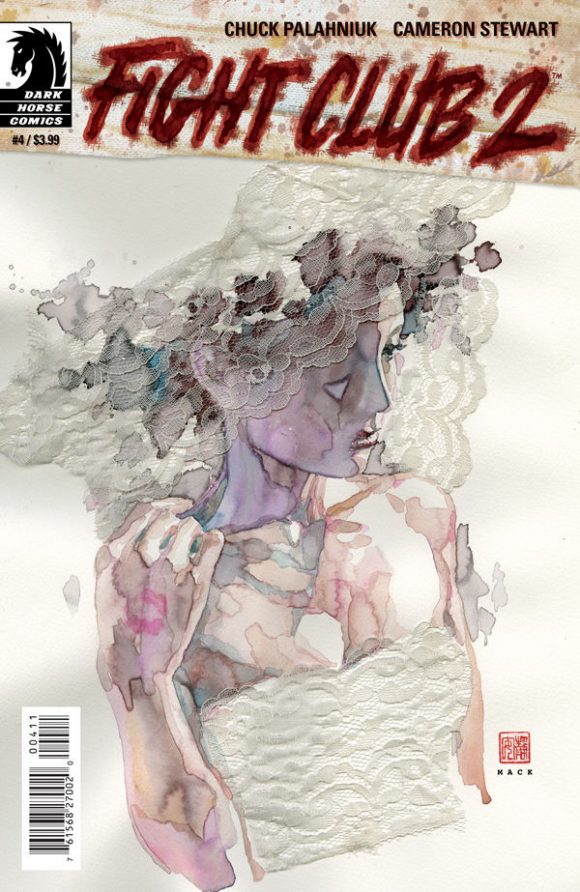
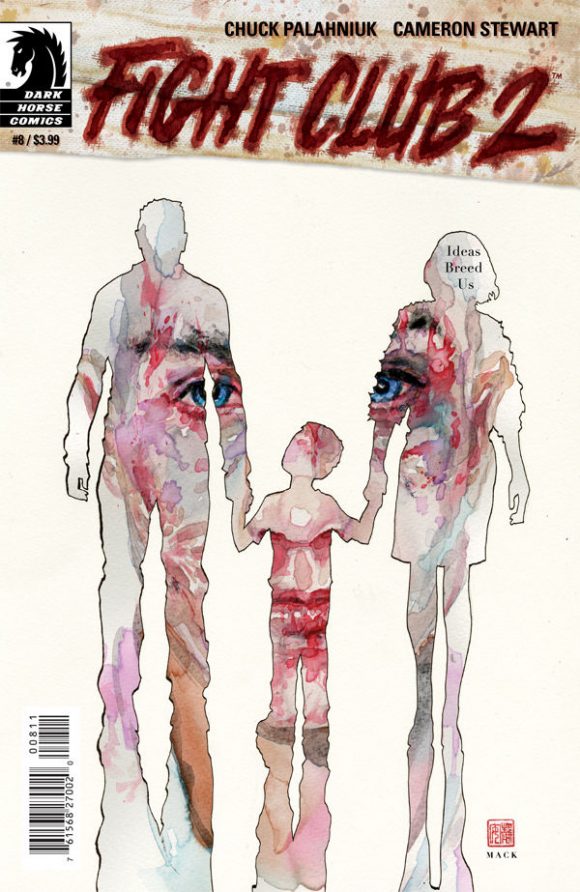
Trackbacks/Pingbacks